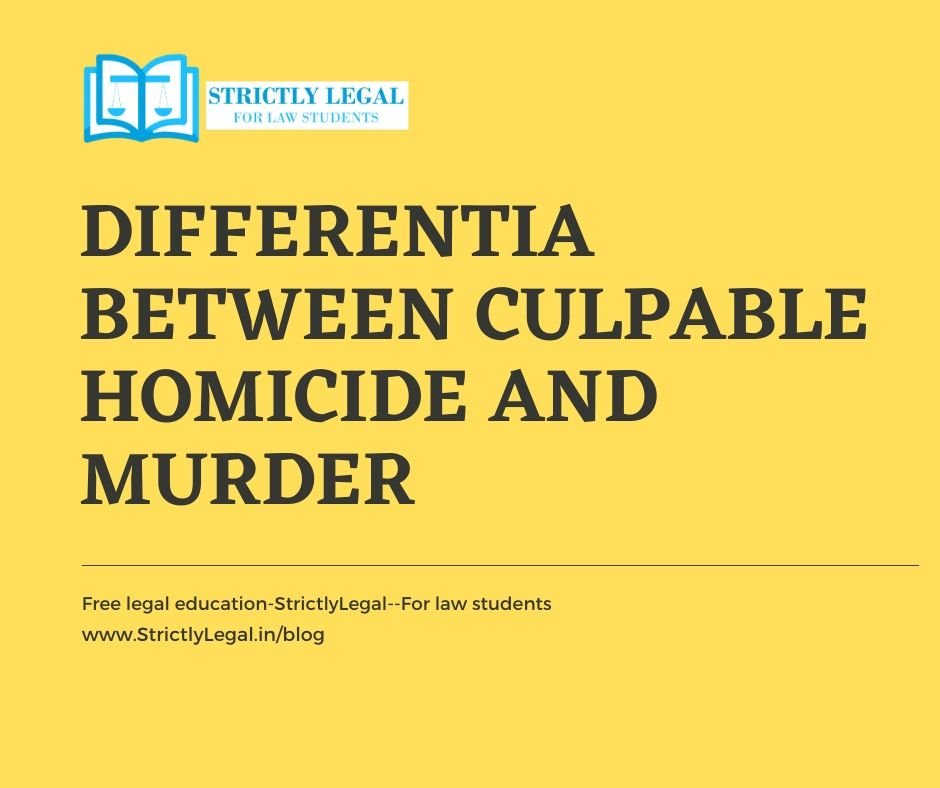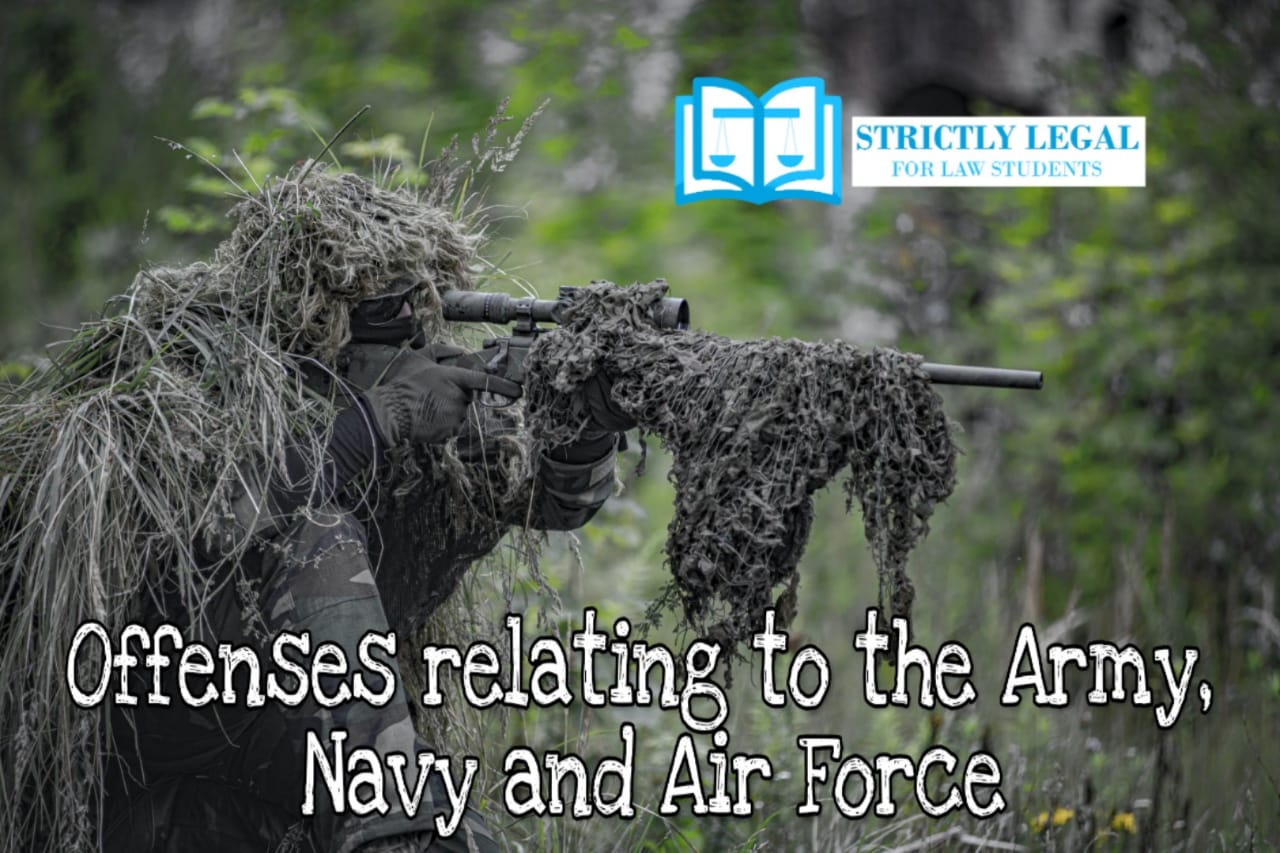Confusion between culpable homicide and murder is common amongst law students and even lawyers. This perplexity is understandable considering the kindred nature of the offences. In the light of the aforementioned complication, this article has been written for lucid apprehension for anyone seeking to study the topic. Before you start reading, it is to be bear in mind that only the brief aspects of said offences have been covered in the article, so that as soon as you finish your reading, you are in a position to easily comprehend the distinction between the two crimes.
Culpable homicide has been defined under section 299 of the Indian Penal Code and is punishable under section 304 of the same Code. Murder, on the other hand, has been discussed under section 300 of the IPC and is punishable under section 302 of the Code.
Table of Contents
Bare Act definition of section 299 and section 300 respectively:
Section 299 Culpable homicide: Whoever causes death by doing an act with the intention of causing death, or with the intention of causing such bodily injury as is likely to cause death, or with the knowledge that he is likely by such act to cause death, commits the offence of culpable homicide.
Section 300 Murder: Except in the cases hereinafter excepted, culpable homicide is murder, if the act by which the death is caused is done with the intention of causing death, or-
Secondly,- if it is done with the intention of causing such bodily injury as the offender knows to be likely to cause the death of the person to whom the harm is caused, or-
Thirdly,- if it is done with the intention of causing bodily injury to any person and the bodily injury intended to be inflicted is sufficient in the ordinary course of nature to cause death, or-
Fourthly,- if the person committing the act knows that it is so imminently dangerous that it must, in all probability, cause death or such bodily injury as is likely to cause death, and commits such act without any excuse for incurring the risk of causing death or such injury as aforesaid.
Sine Qua Nons of Section 299
Definitions plainly imply that anything that falls under the exceptions of murder is regarded as culpable homicide. However, there are two sine qua nons for an act to fall under these exceptions to attract section 299. These are intention and knowledge.
– Intention to kill a person.
For instance, X knows that Y is hiding behind the curtains, while Z doesn’t. X, for the purpose of causing death to Y, instigates Z to shoot at the curtains. Z shoots and consequently Y dies on the spot. By law, Z won’t be charged for anything, but X will be convicted for culpable homicide.
– Intention to cause such body injury to a person that can later result in victim’s death.
Let’s say there’s a deep pit. R knows that if S falls in the pit, she is most likely to die. With this intention, R lays a cloth and covers the pit. S believing the ground to be firm, treads on the cloth, falls and dies. Here the offence committed would fall under the ambit of culpable homicide.
– knowledge that by such an act, the offender is most likely to cause death to the victim.
Suppose O has full knowledge that P has recently gone through a head injury. Therefore, his head is extremely sensitive, where even the minor injury can cause him cerebral bleed. For the purpose of killing P, O hits him with a wooden stick, with a degree that in normal course wouldn’t kill a person but only harm him. P later dies with this blow. O here, will be charged with culpable homicide.
On 24th July 2012, the court in Rampal Singh v. State of Uttar Pradesh [8 SCC 289: 2012 (7) JT (10): 2012 (6) SCALE 574: 2012 Cr LJ 3765], held that “culpable homicide” is the genus and “murder” is its species and all “murders” are “culpable homicides”, but all “culpable homicides” are not “murders”.
Exceptions of Murder
Following are the exceptions that distinct culpable homicide from murder:
Provocation:
An action cannot deemed to be a murder if it has taken place due to sudden and grave provocation. Death caused by provocation of the person who provoked the other person or of any other person by mistake or accident is called culpable homicide. For example, D gives grave and sudden provocation to E. In the heat of the moment, E fires the pistol at D. His intentions were neither to kill D nor he had the knowledge that firing can kill D at that time. D nonetheless dies. The action of E here won’t amount to murder but culpable homicide.
Provisos of provocation
The exception of provocation is further subject to the following provisos:
– That the provocation shouldn’t have been caused voluntarily to later commit an offence, of either killing or harming, as an excuse.
As an example: N wants to kill M, but being a law student she knows that if she kills M without a cause, she will be charged with his murder. Hence, she voluntarily provokes M to harm her. Under the influence of passion excited by N, M picks up the knife to attack N. Taking this as a provocation, N reaches for her gun and shoots M, consequently killing him. This case won’t uphold section 299 as it was a pre- planned provocation to commit a murder.
– That provocation cannot be regarded as provocation if the act done by a person is within law.
If a public servant- a police officer while dealing with an armed citizen, reaches for his gun, this act cannot be considered as a provocation for that citizen to take out his gun and shoot the officer.
– That if a person is exercising his right to private defense within legal boundaries, his actions cannot be beseeched as provocation by someone else.
For instance, B is angrily running towards A with a sword in his hand. In the fear that B might kill A, A tries to seize the sword and points it back to B in his self-defense. This provokes B for A daring to point the sword at him. B snatches the sword back and kills A. This action will straightaway amount to murder because A was in the capacity by law to grapple B’s sword in his private defense.
Tests for grave and sudden provocation
Although whether the provocation was grave and sudden to perpetrate culpable homicide is a question of fact. Through years the courts have come to diagnose ‘grave and sudden’ provocation via tests. One such test is putting a reasonable man, belonging from the same social background as accused and situating him in the circumstance alike, to see if he would be as provoked in the situation as the accused and lose his self-control. Reasonable man’s test also, howbeit, is branched with few factors. Foremost factor is time. It is crucial to consider whether sufficient time has elapsed since the receiving of the information that resulted provocation to allow a reasonable man to calm down. The landmark case for this test is K.M Nanavati v. State of Maharashtra, AIR 1962 SC 605.
In a diverse society as India, one must take note that certain words and gestures may also cause grave and sudden provocation to people. It is not necessary that the person (who is a potential victim) intents to provoke someone (potential offender). For example, if a politician says something provocative and agitated by his speech one of his rally attendee throws a brick at him, and the politician dies, it will result in culpable homicide.
Another test for sudden and grave provocation is the mental background check of the victim. Courts scrutinize the history of victim’s previous actions to identify whether his action in question is adequate to cause grave and sudden provocation or not. For instance, if a mad person who is known to unintentionally offend people by his actions and words, says something provocative to a person who is apprise of his condition, cannot be said to cause grave and sudden provocation. If the person hits the mad man in anger, he is committing murder and not culpable homicide. You can refer to Venkatesan v. State of Tamil Nadu (1997) for this test.
Self-defence
This exception is inclusive of private defense of a person or property. If a person kills somebody while defending himself or a property from that person, intending no harm than necessary for the purpose of defending himself or the property, shall said to have committed culpable homicide. Given, the accused should’ve practiced self-defense in good faith and with no premeditation. Let’s take the example of O and P. O is a resident of Kashmir, and so is P. One day O starts pelting stones on P, not intending to cause death or grievous hurt, but to scare away P out of Kashmir. In self-defense, P points a gun at O, which doesn’t stops O from pelting stones and injuring P. Believing that there is no way to save himself from O, P shoots O dead. Here P will be charged for culpable homicide.
Exceeded lawful duties
This exception talks about the actions of public servants or people aiding public servants. Basically anything done under the authority or supervision or by public servants are all inclusive of the third exception to murder. For example, H is a police officer and I is a dangerous criminal. H is not supposed to kill I. I is fully armed and is planning to plant a bomb. While chasing I, H warns him multiple times to surrender himself and his weapons but I continues to run. Believing that more delay would result in increased danger to public, H shoots and I dies. In this case, H won’t be charged for murder, even though he killed a criminal that he wasn’t supposed to, but for culpable homicide for exceeding his licit prerogative for public protection, and with no ill will towards the dead.
The aforementioned exception not only safeguards public servants from section 300 but also lays duty on them to operate legitimately. For example, four police officers debar a dark skinned man on the suspicion that he is dangerous. Post thorough checking and confirming that the man is disarmed, an officer lays the man down on the road and presses his knee on his throat. The man dies in suffocation. Had this case of George Floyd happened in India, the police officer would have been convicted for murder. This case clearly shows the ill-will of the officer towards the victim and exploitation of powers rendered to him.
Undue advantage and cruelty
As per this exception, an unplanned action, occurred at the time of a sudden fight due to the heat of the moment, where the offender had not taken any undue advantage of the situation or had not acted in unusual or cruel manner than needed, shall be characterized as culpable homicide.
Requisites to invoke section 300
Following constitute for requisites to invoke section 300:
– Sudden fight: As in the case of K. M Nanavati v. State of Maharashtra, time is of essence. Like mentioned, time between the provocation and reaction is paramount. For an act to come under the ambit of fourth exception to section 300, the fight should be sudden. A pre-planned fight where a person is killing another person in excitement, will signify murder. In an altercation, if one of two people under the influence of excitement, kills the opponent, the offence would be that of culpable homicide.
– No premeditation: Premeditation means planned. If court finds that any part of a situation is premeditated, section 300 will come in play. Suppose J and K are two employees at a firm, competing for the same position. J envies K. Hence, to magnify his promotion prospects, J plans a fight with K where he’d eventually kill him, behind the veil of anger and provocation. Same happens, and J gets convicted for murder. Court in its findings observes that J was aware, that in fit of anger K will be provoked to say provocative things to J. Hence, this knowledge is enough to charge J for murder. Sayaji Hanmat Baukar v. State of Maharashtra, AIR 2011 [SC 3172: JT 2011 (7) SC 311: (2011) 7 SCALE 710: 2011 Cr LJ 4338] is a relevant case law for this exception.
– Act to have been done in the heat of passion: The point simply means that until and unless a person is provoked or is anguished in a situation, he has no reason to attack another person. If in a fight, two people abuse each other and none of them is actually provoked by the words, none of them can harm the other. Any action, not done instantaneously will amount to murder. In case, one of them gets triggered and kill the other person due to that provocation, the action will fall for culpable homicide.
– Absence of undue advantage or cruelty or unusual behavior of the assailant: This is one of the important aspect of the fourth exception. While court takes careful cognizance of the offender’s behavior before the offence, it also minutely looks at the behavior portrayed during and after the offence. If it was to be found that the gravity of offence committed by the victim is minimal as compare to the self-defense exercised by the accused, then that self-defense will amount to murder. Let’s say F slapped G. G in return shot F dead. G here, won’t be said to have been practicing self-defense. On the contrary, if F tries to stab G with a knife and in fear that F might kill him, G shoots him on a blank point, then G will be entitled to the benefit of this exception. It is so because G is not taking any undue advantage, may it be for past revenge or anger, of the situation, but purely encountering the threat. If we extend the said situation and assume that after shooting F, G comes over to F’s body and start cutting his body parts, the extension won’t be culpable homicide. The right of self-defense will end immediately after G shoots F. As soon as the threat on G’s life is over, he cannot attack F as his self-defense. The act will be counted for a separate attack and be labelled as per its nature, but not culpable homicide. Similarly, if the assailant portrays unusual behavior in the name of self-defense, then that will be crucially taken into consideration while invoking section 300. In the discussed exception, the fact who initiated the assault or provocation becomes immaterial. The focus here tends to shift on the degree and nature of the offence done as self-defense or as a result of provocation. As mentioned, if the facts indicate the offender to have taken undue advantage of the situation or showcasing cruelty or unusual behavior on the victim, he doesn’t gets the benefit of this exception.
Death with the consent of a major
The fifth exception covers deaths that are caused either by the consent of a major or by the risk that a major while knowing that it can cause death, has taken.
– By consent: As an example: K, a major, being severely sick from a condition, expresses his wish to die to a friend. The friend acts accordingly and his actions cause K’s death. The friend has commited (lawful) culpable homicide.
– By taking risk where death is a probability: For instance, T takes part in a car racing competition. Before the race, the organizers ask him to sign a consent form which explicitly states that any injury, including death, caused during the race will not be a responsibility of the organizers, but the contender’s signing the form. T agrees and signs the form. During the race his car crashes with another car and T dies. The organizers would have said to commit (lawful) culpable homicide.
Needless to mention, a consent expressed by a minor becomes invalid. In the eyes of law a minor is mentally incapacitated to comprehend his best interest. A minor will always need his legal guardian to act as a consenting major in any matter. For example, if a minor Q gives her consent to her mother R to take her off the ventilator while she remains in critical condition, the consent will come as invalid. If the mother herself, on acting on Q’s wish, removes her from the ventilating machine, she is committing murder. In another situation, R is instigating Q (a minor) to commit suicide. Since Q is not in the position to give consent to her own death, R is abetting murder.
When we speak of murder, it becomes a broader term. In a circumstance where there is no excuse for a person to cause death or such bodily injury that shall cause death, attaches him to the crime of murder. Therefore, an act, done with the knowledge of its consequences is not a prima facie murder, unless there’s no affirmation of any sort of excuse (such as provocation, self-defense etc.). The extreme recklessness cannot constitute to murder, until it is proven that such an act was wholly inexcusable. Emperor v. Dhirajia, AIR 1940, can be referred to, to understand the concept. Since murder is an offence of gravest degree and is punishable severely, courts take close precautions while discerning a crime as murder.
Sine Qua Nons for Murder
The Bare Act definition of section 300 covers the sine qua nons for an offence to be identified as murder.
– Clause one: Clear intention to kill a person.
The intention of killing a person is primary. The accused shouldn’t have an excuse, that fall under the section’s exceptions, to kill a person. An act done to clearly cause death to another person amounts to murder. For example, a police officer suffocates a dark skinned man, out of his personal bias against dark skin. The officer shall be held liable for murder.
– Clause two: Intention of causing such body injury that will result in death.
If a person intents to harm someone in such a way that will surely result in person’s death, then the action can be characterized as murder. Let’s say U is an infant. V, his father, drops him off a three storey building. Considering that the victim is an infant, the fall is enough to cause his death. The baby however, first suffers serious injuries and then dies. Here, V will be convicted for U’s murder.
– Clause three: Causing such body injury, that in ordinary course is enough to cause death.
To attract clause thirdly of this section, the court determines all the facts and circumstances of a case. It is so because one action can give multiple reactions. For instance, W stabs knife in X’s abdomen. The doctors in their report corroborate that such gravity, in normal case, will be enough to kill somebody i.e. the injury in this case was sufficient to cause death. Therefore, the intensity of the penetration became the determining factor of the offence under this clause. In the absence of any circumstance that otherwise can prove the action to be unintentional or accidental, it will have to be presumed that W intentionally caused the injury to kill X. Virsa Singh v. State of Punjab, AIR 1958 SC 465 is a landmark judgment on this clause.
– Clause four: Knowledge of an act that will, in all possibilities, cause death.
Culpable homicide turns into murder when the accused is fully aware of the consequences of his actions. If a person knows that severely damaging the internal organs along with vital body parts, will kill a person, this knowledge will be enough for him to be charged with murder. If the prosecution draws the conclusion of guilt, it has to be beyond all reasonable doubts and must be consistent with the guilt of the accused. S.D Soni v. State of Gujarat, (1991) Cr LJ 330(SC) is a relevant case law for the same.
Conclusion
This is what broadly differentiates culpable homicide from murder. To conclude, sometimes the line between two closely related crimes is not as thin as it may appear.

Users not registered with Strictlylegal can Email us their content and the same are posted through this account. In case of abuse, kindly let us know at [email protected]




